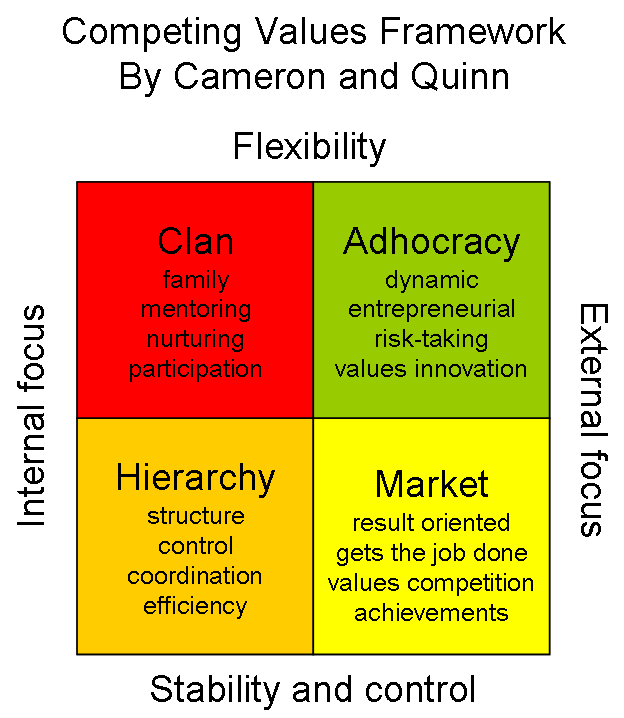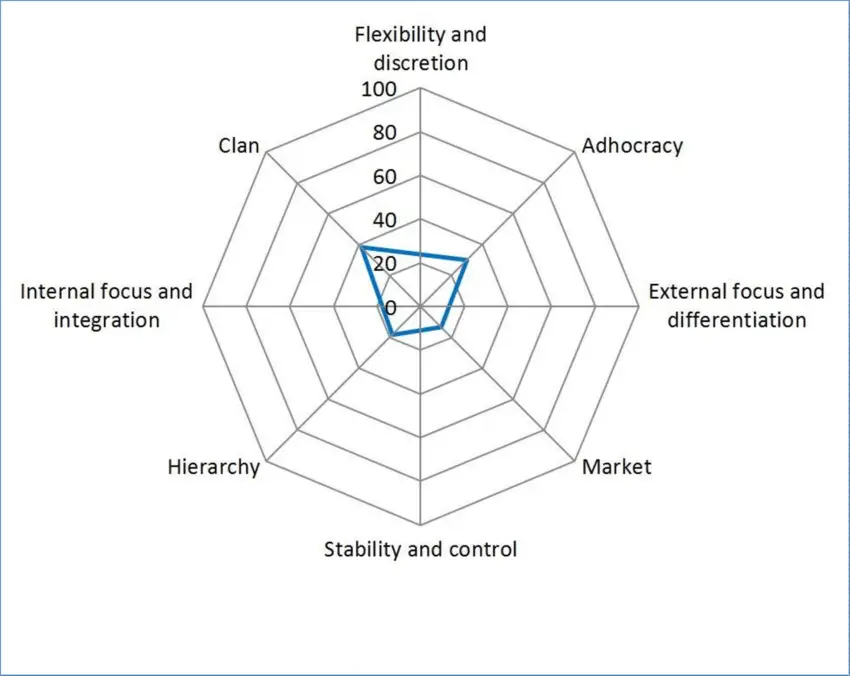Cameron and Quinn Competing Values Framework | Hierarchy Culture| Market Culture| Clan Culture | Adhocracy
Kim Cameron and Robert Quinn both developed an organizational culture framework model based on a theoretical model called the “Competing Values Framework (CVF).” CVF model is based on the book Diagnosing and Changing Organizational Culture, published in 1999. The framework can help companies diagnose and initiate change in their organizational culture.
The highlights whether the organization is a predominant internal or external focus and whether it strives for flexibility and individuality or stability and control.
The Competing Values Framework is also based on six organizational culture dimensions and four dominant culture types, including hierarchy culture, clan culture, adhocracy culture, and market culture. Additionally, the competing values framework authors generated an “Organizational Culture Assessment Instrument (OCAI),” which is used to identify the organizational culture profile based on the core values, assumptions, interpretations, and approaches that characterize organizations.
Competing values framework gives a classification of four corporate cultures and indicates how a company operates, how employees collaborate, and corporate values.
Competing Values Framework Culture
The CVF model consists of two dimensions, one place vertically and the other placed horizontally in the model.
Vertical Dimensions
The vertical dimension differentiates between organizations at the top that emphasize flexibility, discretion, and dynamism and organizations at the bottom that emphasize stability, order, and control.

Organizations at the top are viewed as effective if they are changing, adaptable and organic. Neither the product mix nor the organizational form stays in places very long at firms such as Google or Nike, for example.
Organizations at the bottom are viewed as effective if they are stable, predictable, and mechanistic. Most universities, government agencies, and conglomerates such as Boeing or VW are characterized by longevity and staying power in both design and output.
The horizontal dimension differentiates between organizations that emphasize an internal orientation, integration, and unity and organizations that emphasize an external orientation, differentiation, and rivalry.
Some organizations are viewed as effective if they have harmonious internal characteristics. IBM has traditionally been recognized for a consistent IBM way.
Other organizations are judged to be effective if they are focused on interacting or competing with others outside their boundaries. For example, Toyota and Honda are known for thinking globally but acting locally.
Together, these two dimensions form four quadrants. These are;
- The Hierarchy Culture,
- The Market Culture,
- The Clan Culture,
- The Adhocracy Culture.
Hierarchy Culture in Organizations
Characteristics of Hierarchy Culture companies includes;
- A controlling environment characterizes the hierarchy culture in the bottom left quadrant. The hierarchy culture is characterized by a formalized and structured workplace. Procedures and controls govern what people do.
- Effective leaders are good coordinators, organizer’s and monitors. Maintaining a smoothly running organization is important. The long-term concerns of the organization are stability, predictability, and efficiency.
- Formal rules and policies hold the organization together.
- Success is defined in clear lines of decision making, authority, control functions, and accountability mechanisms.
The Hierarchy Culture Example
Examples of organizations are fast-food restaurants such as McDonald’s or a government agency that is responsible for controls in airports. In both organizations, there are strict guidelines for every small detail.
Market Culture Companies
Characteristics of Market Culture companies includes;
- A competing environment characterizes the market culture in the bottom right quadrant. The market culture is a result-oriented workplace. The basic assumptions in the market culture are that;
The external environment is hostile rather than benign.
Consumers are selective and interested in the value.
Leaders are hard-driving producers.
Competitors who are tough and demanding.
- The major task of management is to drive the organization towards productivity results and profits. The glue that holds the organization together is an emphasis on winning.
- Success is defined in terms of market share and penetration.
Organization market culture examples
Examples of organizations are Ikea, a worldwide furniture chain, or Walmart, a retail chain. The goal is to outpace the competition and be market leaders.
Clan Culture Organizations
Characteristics of Clan Culture companies includes;
- A collaborating environment characterizes the clan culture in the upper left quadrant. The clan culture is typified by a friendly place to work where people share a lot of themselves. It is like an extended family.
- Leaders are thought of as mentors, facilitators, team builders, and perhaps even parent figures.
- The organization is held together by loyalty and tradition.
- Commitment is high.
- The organization emphasizes the long-term benefit of individual development, with high cohesion and morale being important.
- Success is defined in terms of internal climate and concern for people.
- The organization places a premium on teamwork, participation, and consensus.
Clan Culture Organization Example
Examples of Clan Culture organizations are small family-owned companies and some NGO’s, like Doctors Without Borders or the free online encyclopedia Wikipedia.
Adhocracy Organizational Culture
Characteristics of Adhocracy Culture companies includes;
- A creative environment characterizes the Adhocracy culture in the upper right quadrant. The Adhocracy culture is a dynamic, entrepreneurial, and creative place to work.
- People stick their necks out and take risks.
- Effective leadership is visionary, innovative, and risk-oriented.
- The glue that holds the organization together is a commitment to experimentation and innovation.
- The emphasis is on being at the leading edge of new knowledge products and services.
- Readiness for change on meeting new challenges is essential.
- The organization’s long-term emphasis is on rapid growth and acquiring new resources.
- Success means producing unique and original products and services.
Adhocracy Organizational Culture Examples
Examples of organizations are startups, most of which are entrepreneurial ventures.

Competing Values Framework Organizational Culture Relationship
- Each of the four sides of the model highlights a core value that is the opposite of the value on the model’s opposite side—flexibility versus stability internal versus external.
- The dimensions, therefore, produce quadrants that are also contradictory or competing on the diagonal.
- The clan culture in the upper left quadrant identifies values that emphasize an internal organic focus. In contrast, the market in the lower right quadrant identifies values that emphasize an external control focus.
- Similarly, the upper right quadrant’s adhocracy culture identifies values that emphasize an external organic focus, whereas the lower left quadrant’s hierarchy culture emphasizes internal control values. The competing or opposite values in each quadrant give rise to the model’s name, the competing values framework.
Organizational Culture Assessment Instrument
Most organizations develop a dominant cultural style. The competing values framework serves as a way to diagnose and initiate change in the culture that organizations develop as they progress through their life cycles.
Because most organizations’ culture is invisible and taken for granted, most organization members have a difficult time identifying or describing it, let alone consciously changing it. This is where the Organizational Culture Assessment Instrument (OCAI)can be especially useful for using the tool in practice.
The Organizational Culture Assessment Instrument test consists of two parts; in both parts of the test, you must distribute 100 points on the four cultures that are in the model.
- Test 1: The first part of the test shows where your culture is placed right now, and the
- Test 2: the second part of the test shows where you prefer the organization to be placed in the future.

When you want to change your organization’s culture, you have to ask yourselves the following three questions in each of the four cultures.
- What should we do more?
- What should we start?
- What should we stop?
There is no such thing as a standard, best or right culture. Many different factors determine whether an organization has the right culture at the right time.
Competing Values Framework Culture Examples
Here are two examples of organizations that usually have different cultural profiles. The first is a high-tech manufacturer. They have to develop new technology all the time. The dominant culture is adhocracy.
The second is a government agency. They need to have their procedures and rules in place. There must be no mistakes. The dominant culture is the hierarchy.
The two cultures are different but probably right for the individual organization. Both can change over time.
Competing Values Framework Culture Examples
Apple Organizational Culture and Structure
The Apple organizational culture and structure change from 1980 to 2000 and a little beyond Steve Jobs and Stephen Wozniak invented the first personal computer and started the Apple Company.
At first, Apple’s culture was dominated by a single entrepreneurial, charismatic leader Steve Jobs, who was setting direction, and the company was flexible and freewheeling. The people hired were young, dynamic, unconstrained California folks who prided themselves on being free of policy manuals and rulebooks.
The press described the group as renegades and crazies. The cultural profile involved a high degree of emphasis in the adhocracy culture Quadrant, moderate scores in the clan culture quadrant, and a low score in the hierarchy and market quadrants.

Apple’s culture was dominated by an entrepreneurial, innovative adhocracy culture and place in the upper right quadrant.
The second culture profile emerged within a few years. Apple established was one of the most successful ventures ever experienced in the industry. The formation of a group of pirates. This small group of Apple computer pirates designed and developed the Revolutionary Macintosh computer.
The team’s endeavors were so successful that the entire organization adopted the team culture. Employees wore apple logos on their clothes, had Apple bumper stickers on their cars, and spoke warmly of the Apple family. Apple came to be a highly cohesive clan.
Apple’s culture was dominated by a clan and adhocracy culture and placed in the upper left and right quadrants.
The enormous success of the Apple company led it towards the third kind of culture. However, with hundreds of thousands of computers being sold, distribution channels expanding worldwide, and the emergence of a large array of highly competitive rivals, the freewheeling clan faced the need for controls and standard procedures.
Policies and regulations were needed. In other words, a hierarchy orientation culture had to be developed and placed in the bottom left quadrant.
The founder and CEO, Steve Jobs, was the quintessential innovator and team leader perfectly comfortable in an organization dominated by adhocracy culture and clan culture. However, he was not an efficiency expert and administrator and was not inclined to manage a hierarchy culture.
John Sculley was hired to manage the shift to stability and control. The new set of values and priorities reflected in the new culture made Jobs is orientation out of sync with current demands. The founder, Steve Jobs, was fired from the company.
The dominant competencies preferred in the third Culture profile by John Sculley are in the diagonal quadrant, opposite from the first culture profile managed by Steve Jobs.
In short, Steve Jobs as an adhocracy culture leader, was a rule-breaker, whereas John Sculley, as a hierarchy leader, was a rule enforcer. Steve Jobs had to lose the battle if the company was to grow.
The fourth culture profile emerged when Apple developed into a large, mature organization under Scully. It ceased to be the agile, innovative company that had characterized the young group of renegades in its early life.
Instead, it was an outstanding example of efficiency and marketing savvy. The organization became more a manufacturing company than a techno company. Apple’s culture was dominated by hierarchy and market culture and placed in the bottom left and right Quadrants.
The fifth cultural profile took longer to emerge. Over time, companies tend to gravitate towards an emphasis on the hierarchy and market culture types. The lower quadrants tend to remain dominant, the longest.
It takes a great deal of effort and leadership to make the change to clan and adhocracy culture. That was one of the reasons that Apple had performance difficulties in the late 1990s. The company was stuck in the bottom two cultures and had a hard time inventing a new product.
Apple had to rehire Steve Jobs to bolster its largely abandoned adhocracy culture. Steve Jobs did not abolish the hierarchy and market culture. Instead, he reinstituted clan and adhocracy culture like attributes so that Apple became a more balanced organization.
The organization developed the capability to shift emphasis between the four different cultures when demands of the competitive environment required it.
They adopted the three questions.
- What should we do more of?
- What should we stop?
- What should we start?
Criticism of Competing Values Framework Culture
The following are the criticisms of Completing Value Framework Model;
- You have to find out for yourself where you are in the model and towards what culture you want to work. There is no help along the way in the model that says whether you have chosen the right direction.
- When talking about culture in this theory, it always deals with organizational culture. National or religious cultures are not taken into account.
- The theory has not included the time and resource aspect. We do not know how long a culture change will take or whether or changes are equally extensive.
The good thing about the model is that it continually forces you to focus on whether your organization has the right culture concerning your organization’s future goals.





